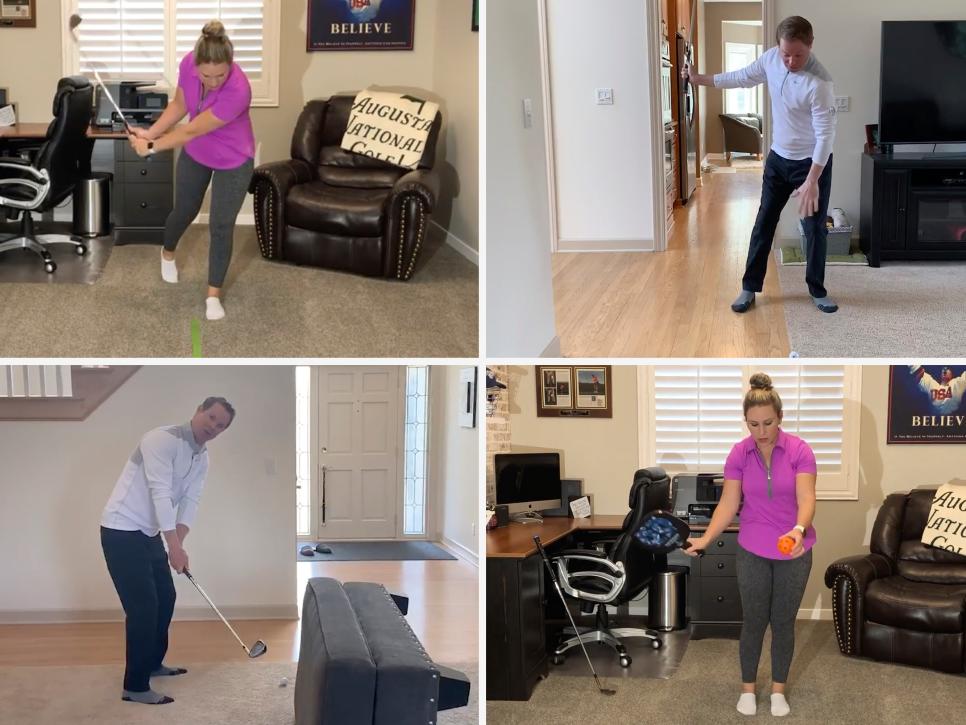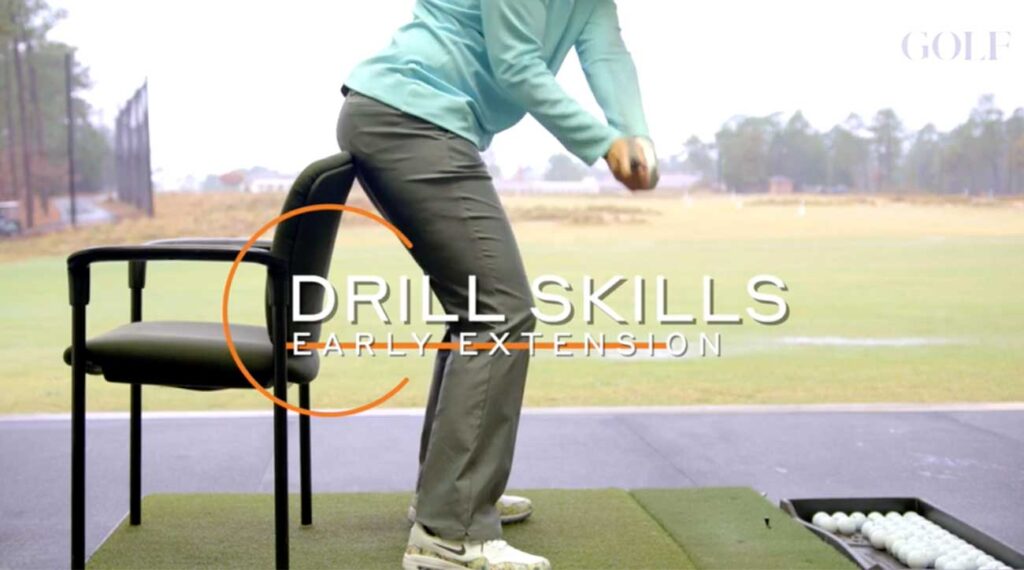You love playing golf, but sometimes the weather doesn’t cooperate, and you find yourself stuck indoors longing to perfect your swing. Don’t worry, there are ways to keep practicing your golf swing even when you can’t hit the course. Whether it’s rainy, snowy, or too dark to play outside, this article will provide you with some helpful tips and techniques to continue honing your golf skills indoors. So get ready to transform your living room or basement into your very own golf practice paradise!

Using a Golf Simulator
Golf simulators provide a fantastic opportunity to practice your swing indoors, especially when the weather doesn’t permit outdoor play. Setting up a golf simulator is relatively straightforward. First, you’ll need a designated space large enough to swing a club comfortably. This could be a garage, basement, spare room, or even an outdoor tent. Make sure you have enough room for your swing and to safely hit the ball without damaging any surrounding objects.
Next, you’ll need to choose the right simulator software. There are several options available, each with its unique features and benefits. Some simulators offer realistic courses, while others focus on swing analysis tools. Consider your goals and preferences when selecting the software that suits you best.
Once your simulator is set up and the software is installed, you can start utilizing swing analysis tools. These tools help you track aspects of your swing such as clubhead speed, swing path, and face angle at impact. By studying these metrics, you can identify areas for improvement and refine your technique. The immediate feedback provided by the simulator allows you to make real-time adjustments and see their impact on your swing.
Using a Practice Net
Another effective method for practicing your golf swing indoors is by using a practice net. Setting up a practice net is simple, and you can do it in any open space that accommodates your swing. Ensure you have enough room behind the net for the ball to come to a complete stop without causing any damage.
To get the most out of your practice net, focus on different aspects of your swing. Start by practicing your alignment and posture. Stand parallel to the net and align your feet, hips, and shoulders perpendicular to the target line. This will help you develop a consistent setup position, which is crucial for a solid swing foundation.
Once your alignment and posture are in check, work on tempo and swing path. Concentrate on smoothly transitioning from your backswing to your downswing, maintaining a balanced and controlled rhythm throughout. The practice net allows you to hit shots repeatedly, allowing you to refine your timing and feel for the clubhead.
Practicing with a Mirror
Using a mirror as a training aid provides valuable visual feedback to improve your swing mechanics. Set up a mirror station in a well-lit area with enough space to swing a club comfortably. Place the mirror at an angle that allows you to view your full body throughout the swing.
When using a mirror, focus on checking your alignment and posture. Stand parallel to the mirror and ensure that your feet, hips, and shoulders are properly aligned. Pay attention to the position of your spine and the angle of your knees. These visual cues will help you develop a consistent setup position.
Additionally, analyze your swing mechanics in the mirror. Take note of your clubface at different stages of the swing, such as at the top of the backswing and impact position. This feedback will allow you to make adjustments to your swing path and grip if necessary. By observing your swing in real-time, you can make immediate corrections and engrain proper mechanics.
Using Indoor Putting Greens
Indoor putting greens are an excellent way to practice your short game from the comfort of your own home. When choosing the right indoor putting green, consider factors such as size, green speed, and quality. Opt for a green that closely mimics the conditions you encounter on real golf courses to make your practice more realistic.
To make the most of your indoor putting green, focus on practicing putting setup and alignment. Develop a consistent routine for addressing the ball, including your stance, grip, and head position. Pay attention to aligning your putter face square to the target line. The more you practice these fundamental aspects, the more confident and consistent your putting stroke will become.
Additionally, work on developing distance control and touch on the indoor putting green. Experiment with different distances and focus on getting the ball to roll smoothly and consistently towards the hole. This will help you become more accurate with your putts, reducing the number of strokes it takes to complete a hole.

Using Practice Aids
Practice aids can be valuable tools to improve specific aspects of your swing. Swing trainers can assist in developing correct positions and movements throughout the swing. They come in various forms, such as alignment sticks, weighted clubs, or specialized training tools. Incorporating these aids into your practice routine can help you reinforce proper mechanics and build muscle memory.
Impact bags and strike boards are another useful practice aid. These tools provide instant feedback on the quality of your strike and help you develop a clean and consistent impact position. By practicing hitting into an impact bag or striking a board, you can train your body to deliver the clubhead correctly and generate more power.
Alignment and tempo tools, such as putting alignment sticks or swing tempo trainers, can enhance your practice sessions. They help you align your body and clubface correctly and develop a smooth and balanced tempo. Adding these aids to your practice routine can improve your overall consistency and accuracy.
Practicing with a Foam Ball
Practicing with foam balls offers several advantages, particularly if you don’t have much space or are concerned about safety. Foam balls are lightweight and won’t cause damage when hit indoors. They also simulate the feel of a real golf ball, giving you a realistic experience during practice.
Before using foam balls, set up a safe practice area. Clear out any fragile items and ensure you have ample space to swing without hindrance. You can even set up a net or use cushions to catch the foam balls and prevent them from rolling away.
Focus on working on swing mechanics and tempo with foam balls. With the limited flight distance, you can concentrate on the quality of your swing rather than the result. Pay attention to proper alignment, grip, posture, and swing plane. The repetitiveness of hitting foam balls allows you to ingrain correct movements and develop a consistent swing.

Incorporating Yoga and Exercise
Improving your flexibility and core strength through yoga and exercise can have a positive impact on your golf swing. Start by incorporating exercises that target your core muscles, such as planks, Russian twists, and abdominal crunches. A strong core helps stabilize your body during the swing, allowing for more precise and powerful movements.
Golf-specific yoga poses can further enhance your physical abilities on the course. Poses like the warrior, triangle, and downward dog help strengthen the muscles used during the golf swing and improve balance and stability. Regularly practicing these poses can increase your body awareness and overall strength, leading to a better swing.
Apart from yoga, engage in golf-specific exercises to enhance your rotational power and stability. Incorporate exercises like medicine ball twists, cable rotations, and resistance band pull-throughs into your routine. These exercises mimic the movements required in your golf swing and help develop the necessary strength and coordination.
Practicing Mental Imagery and Visualization
The mental aspect of golf is just as important as the physical. Practicing mental imagery and visualization allows you to mentally rehearse your swing and improve your performance on the course. Start by understanding the importance of mental imagery in creating a successful outcome.
Create a visualization routine by finding a quiet and comfortable space where you can focus without distractions. Close your eyes and vividly imagine yourself on the course. Visualize the entire swing, from the address position to the follow-through. Feel the club in your hands, hear the sound of the ball being struck, and picture the ball reaching the desired target.
Rehearsing swing execution in your mind can help increase your confidence and build a positive mindset. See yourself hitting the ball with power and accuracy. This mental preparation transfers to your physical swing, allowing you to execute shots with greater consistency and focus.

Analyzing Golf Swing Videos
Recording and analyzing your golf swing videos can provide valuable insights into areas for improvement. Start by recording your swing from different angles, including face-on, down-the-line, and behind the golfer. Position the camera or smartphone securely to ensure a clear view of your swing throughout.
When reviewing the videos, look for swing flaws and areas that require improvement. Pay attention to your grip, posture, swing plane, and weight transfer. Analyze the sequence of your movements and the timing of your swing. Look for any inconsistencies or positions that may be hindering your progress.
While self-analysis is helpful, seeking professional guidance can take your analysis to the next level. A golf instructor or coach can provide expert insight and offer tailored recommendations based on your swing videos. They can identify specific drills or exercises to address your swing flaws and help you make significant improvements.
Utilizing Practice Drills
Practice drills are an effective way to isolate specific aspects of your game and focus on improvement. Work on alignment and clubface control by setting up alignment sticks or markers on the ground. Practice hitting shots while ensuring your clubface remains square to the target throughout the swing. This drill helps develop a more consistent and accurate ball flight.
To improve tempo and rhythm, incorporate rhythm drills into your practice routine. Focus on swinging smoothly and evenly, without rushing or decelerating. Count out a specific rhythm in your head or use a metronome to maintain a steady tempo. Consistently practicing these drills will help you ingrain a balanced and rhythmic swing.
Consistency and accuracy can be developed through various drills. For example, practice hitting balls to specific targets at different distances, aiming for a small landing area. This drill enhances your ability to control distance and direction, leading to more precise shots on the course.
By incorporating these practice drills into your routine, you’ll improve specific aspects of your game, gain greater confidence, and ultimately lower your scores.
In conclusion, there are numerous ways to practice your golf swing indoors. Whether you choose to invest in a golf simulator, set up a practice net, use a mirror, or work on other practice aids, the key is to focus on different aspects of your swing. By dedicating time to alignment, posture, swing mechanics, and tempo, you’ll develop a consistent and effective swing that will carry over to the golf course. Don’t forget to incorporate yoga, visualization techniques, and practice drills to further enhance your skills and mental approach to the game. With dedication and regular practice, you’ll see significant improvements in your golf swing, leading to better performance and enjoyment of the game.






